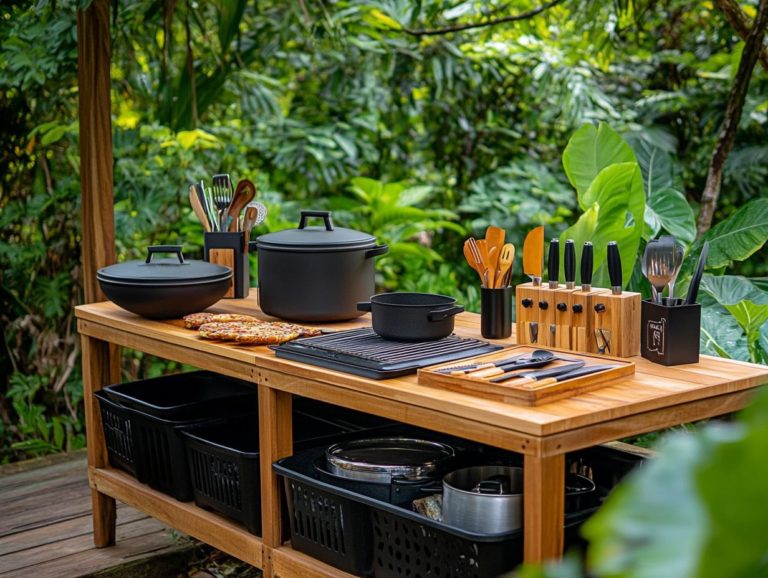What to Look for in Camping Cookware
When preparing for a camping trip, selecting the right camping cookware can transform your outdoor cooking experience from a simple meal into a delightful feast.
This guide covers the crucial factors to consider when choosing camping cookware, including various types and the pros and cons of different materials.
It highlights essential items for your camping kitchen, discusses cooking methods tailored for campfires and stoves, and offers tips to maintain your gear.
Get ready to transform your camping meals into unforgettable experiences!
Contents
Key Takeaways:
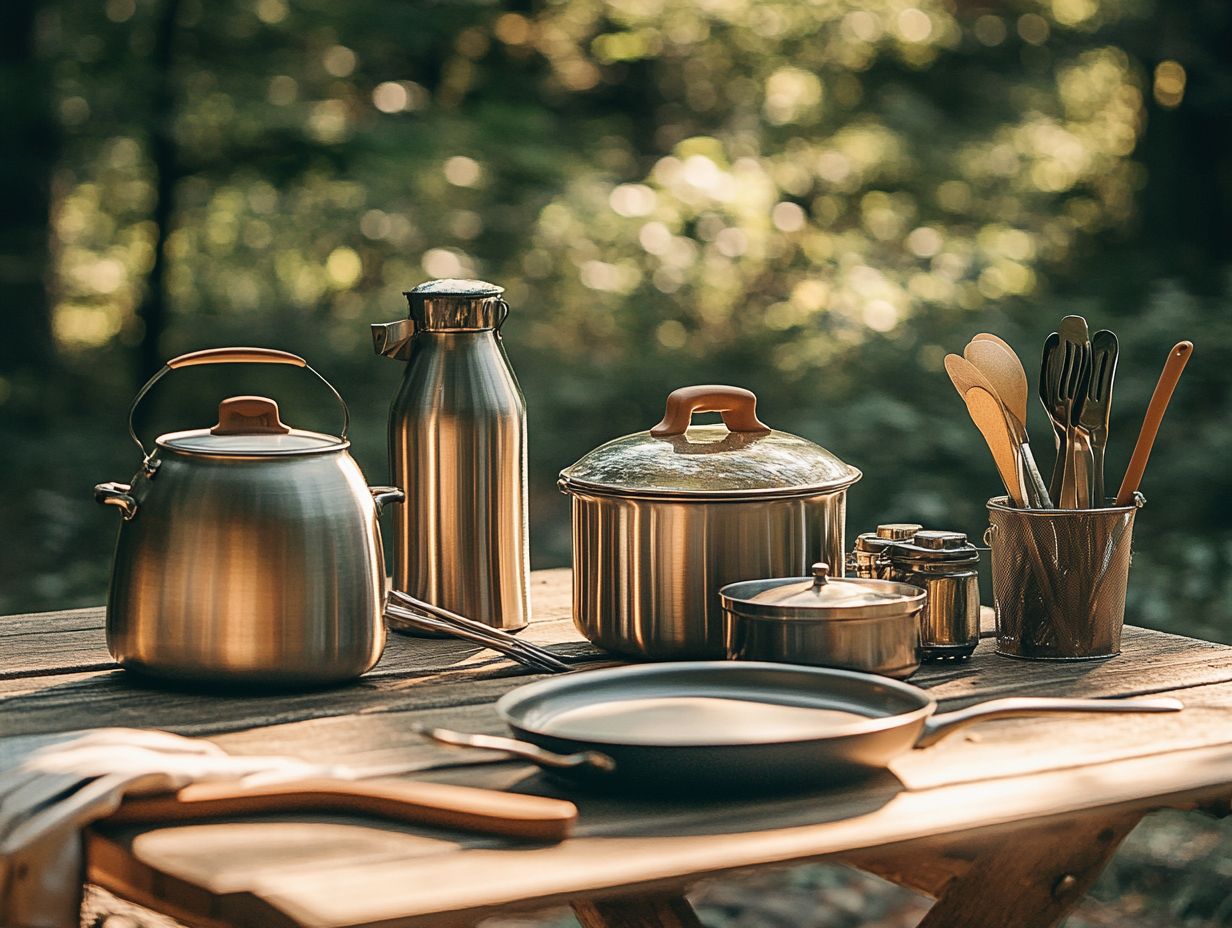
Choosing the Right Camping Cookware
Choosing the right camping cookware is essential for enhancing your outdoor experience. It turns your cooking into a delightful adventure.
With many options available think non-stick pots, ultralight utensils, and nested cooking sets you need to weigh factors like weight, durability, and functionality.
Brands like MSR, Stanley, GSI, and Lodge offer dependable cookware sets tailored to your needs. Whether you’re on a solo backpacking trip or planning a feast for friends, reflect on your cooking habits to make informed choices.
Factors to Consider
When choosing camping cookware, consider key factors like weight, ease of cleaning, and the meals you plan to prepare.
If you prefer backpacking, lightweight gear is crucial. This can significantly improve your comfort and energy on long treks.
If car camping is your style, focus more on functionality, allowing you to bring versatile but potentially heavier equipment.
Regardless of your approach, ensure your cookware is easy to clean, especially if you use eco-friendly soap to lessen your environmental impact. Effective food storage solutions keep meals fresh and enhance your cooking experience.
Types of Camping Cookware
Understanding various camping cookware types is crucial for making informed choices. This is true whether you’re on a solo adventure or cooking for a group.
Your options range from traditional non-stick pots to ultralight utensils and nested cooking sets, each with unique advantages and disadvantages.
Choosing the right cookware can greatly enhance the functionality of your camp stove, making your camping kitchen more efficient and enjoyable.
Pros and Cons of Different Materials
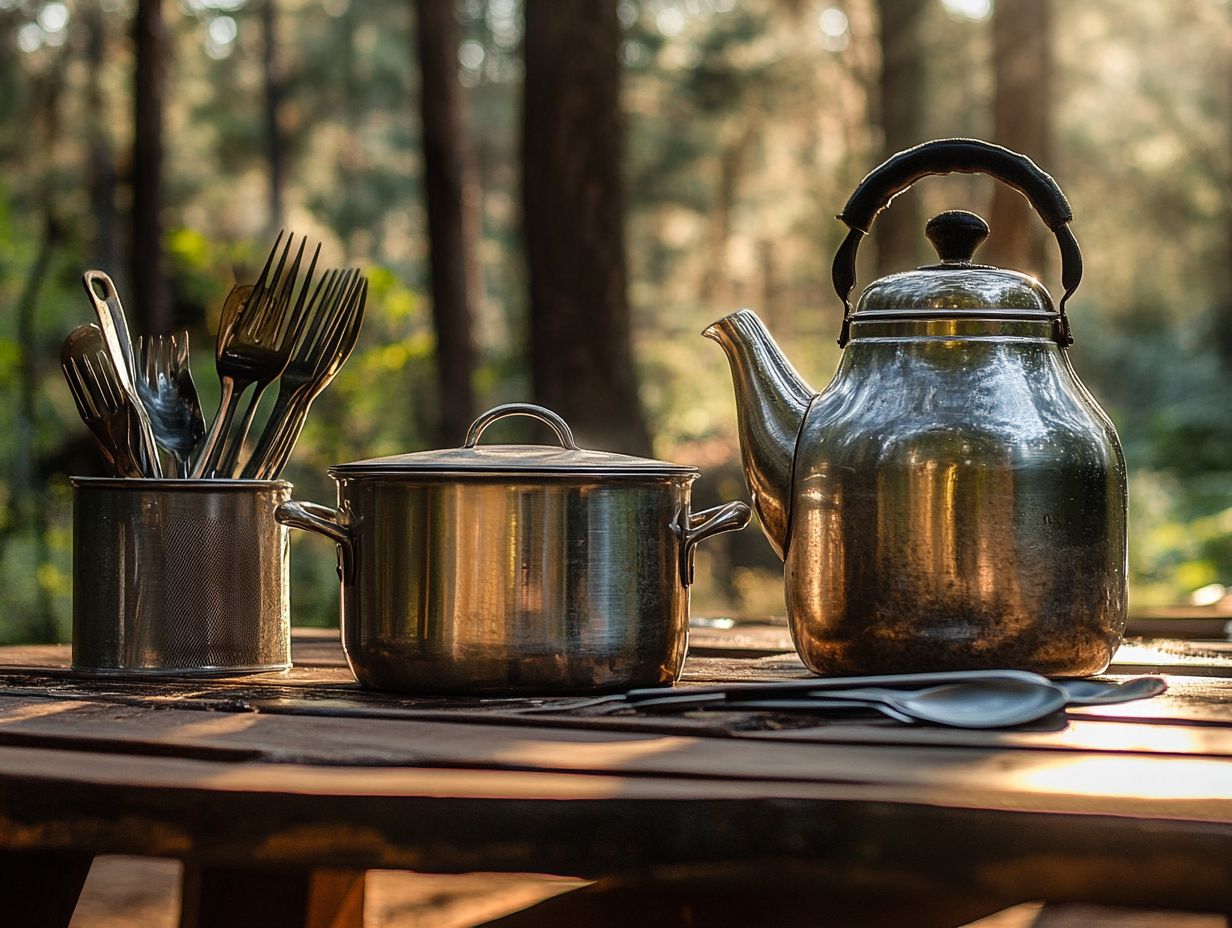
Each type of material in camping cookware comes with its own set of advantages and drawbacks, influencing everything from your cooking performance to weight considerations.
Take non-stick pots, for instance. They re a camper s dream for quick cleanup. This allows you to immerse yourself in nature instead of scrubbing away after meals.
Then there s stainless steel cookware, renowned for its outstanding durability and resistance to warping. It makes for a solid choice for those rugged terrains. While it does weigh a bit more than other options, it can handle rough treatment without breaking a sweat.
And let s not forget about aluminum cookware. Its lightweight nature makes it a favorite among backpackers. However, it can warp and requires a bit of tender loving care (TLC) to maintain its performance over time.
Essential Cookware for Camping
When you re gearing up for a camping trip, selecting the right cookware can profoundly enhance your outdoor cooking experience. Essential items to consider for your camping kitchen include:
- durable camping utensils,
- a dependable camp stove,
- a robust cutting board each playing a vital role in streamlining your meal prep.
Incorporating eco-friendly food storage solutions like Stasher Bags helps you stay organized and supports sustainability in the great outdoors.
Must-Have Items for Outdoor Cooking
Don t miss out on must-have items for your outdoor cooking adventures! A variety of camping cookware will make a big difference!
Essential items include a dependable camp stove, essential utensils, and practical food storage solutions.
Beyond these foundational tools, a quality portable grill can truly enhance your outdoor dining experience, allowing you to enjoy the rich, smoky flavors that only direct flame cooking can provide. Don’t overlook the importance of durable cutting boards and sharp knives they make meal prep in the great outdoors a breeze.
Compact pots and pans specifically designed for grilling or boiling can significantly expand your culinary options. It makes it simple to whip up everything from hearty soups to vibrant stir-fried vegetables. To keep your cooking area clean, be sure to include eco-friendly soap for washing your cookware; it effectively tackles grime while being gentle on the environment, especially important for those using cast iron cookware.
Prioritizing hygiene is essential not only does it ensure that your meals are safe, but it also contributes to an enjoyable camping experience overall.
Cooking Methods for Camping
Explore exciting cooking methods for camping! Whether it’s the enchanting art of campfire cooking or the convenience of a camp stove, these techniques will elevate your meals and enrich your outdoor adventures!
Each method brings its own set of advantages. Imagine the rustic charm of campfire cooking, infusing your meals with a unique flavor, or the sheer convenience of a camp stove, allowing you to whip up dishes in record time.
By understanding these techniques, you ll be well-equipped to cater to everything from solo adventures to memorable group cooking events.
Options for Campfire and Stove Cooking
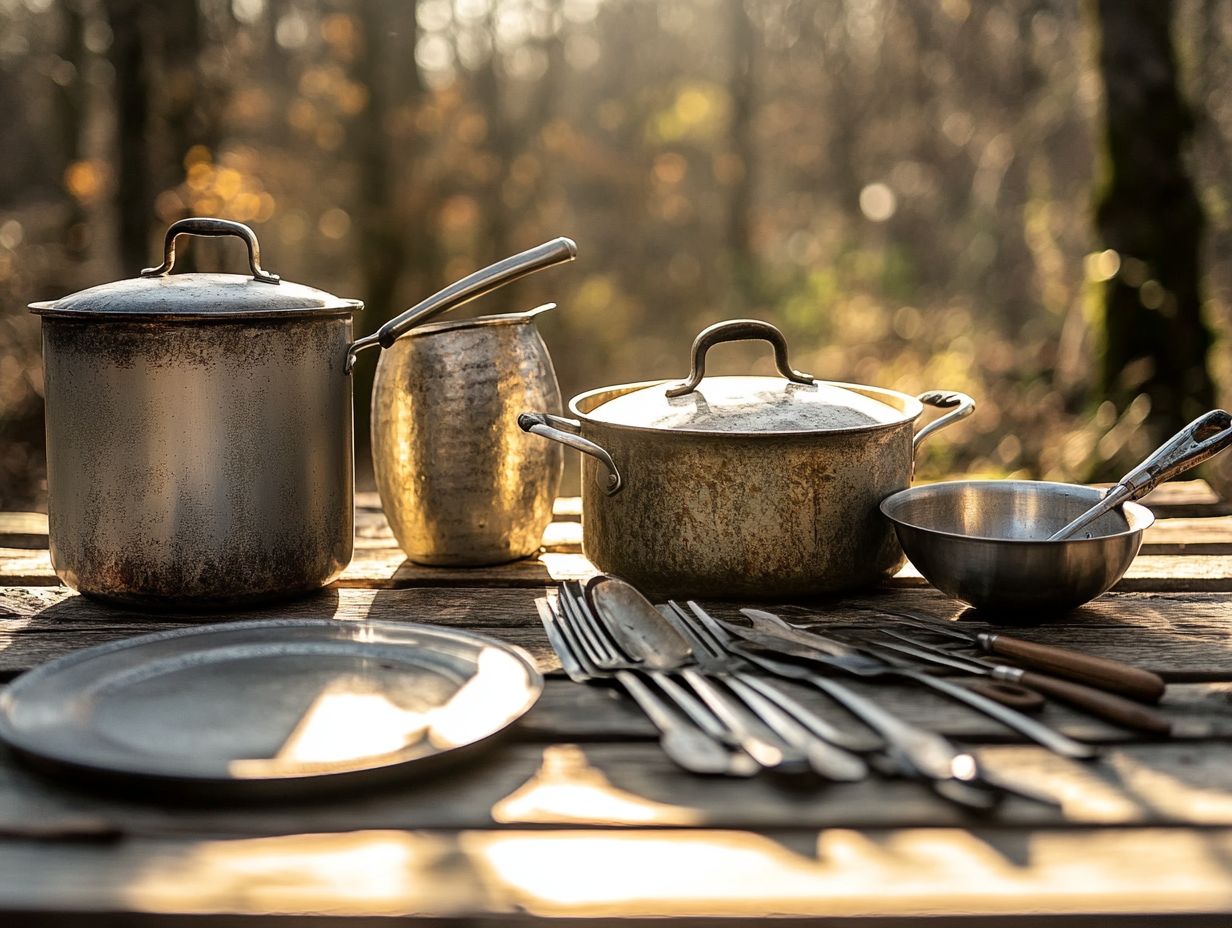
You have many options for campfire and stove cooking. Choose based on your preferences and the meals you want to prepare while camping.
Whether you re drawn to the smoky allure of a crackling campfire or the practicality of a portable propane stove, you can whip up delightful meals with the right techniques. Picture using a cast iron skillet over the fire. You can easily create sizzling breakfast skillets packed with eggs and veggies or hearty dinners featuring seared meats paired with seasonal vegetables!
Stove cooking also offers efficient meal solutions. Imagine preparing a one-pot pasta dish that cooks the pasta and sauce simultaneously, saving you valuable time and minimizing cleanup. Don’t forget to pack essential spices to elevate your outdoor cooking experience!
Consider pre-chopping veggies or marinating meats ahead of time. This will ensure a seamless cooking experience in the great outdoors.
Tips for Maintaining and Storing Cookware
Properly maintaining and storing your camping cookware is crucial for extending its lifespan. This is especially important when you re mindful of weight, whether you re backpacking or car camping.
Regularly clean your cookware with eco-friendly soap. This not only preserves the integrity of the materials but also prevents unwanted contamination in your meals. Thoughtful storage prevents damage and makes it easier to manage your camping gear during your adventures.
Keeping Your Cookware in Good Condition
Maintaining your cookware requires a thoughtful approach to cleaning and upkeep. This ensures your gear operates at its best.
The method varies based on the type of cookware you have, whether it s stainless steel, cast iron, or non-stick. For example, stainless steel benefits from a gentle scrub with eco-friendly soap to tackle stubborn stains. Cast iron needs a good seasoning, which is coating it with oil to maintain its non-stick surface. Non-stick pans should be treated with soft sponges to prevent scratches.
After washing everything, proper storage is key. Hanging pots or utilizing dividers can help minimize unnecessary wear and tear. By implementing these thoughtful storage solutions, you extend the life of your cookware and keep your camping kitchen organized and efficient.
Frequently Asked Questions
What to Look for in Camping Cookware?
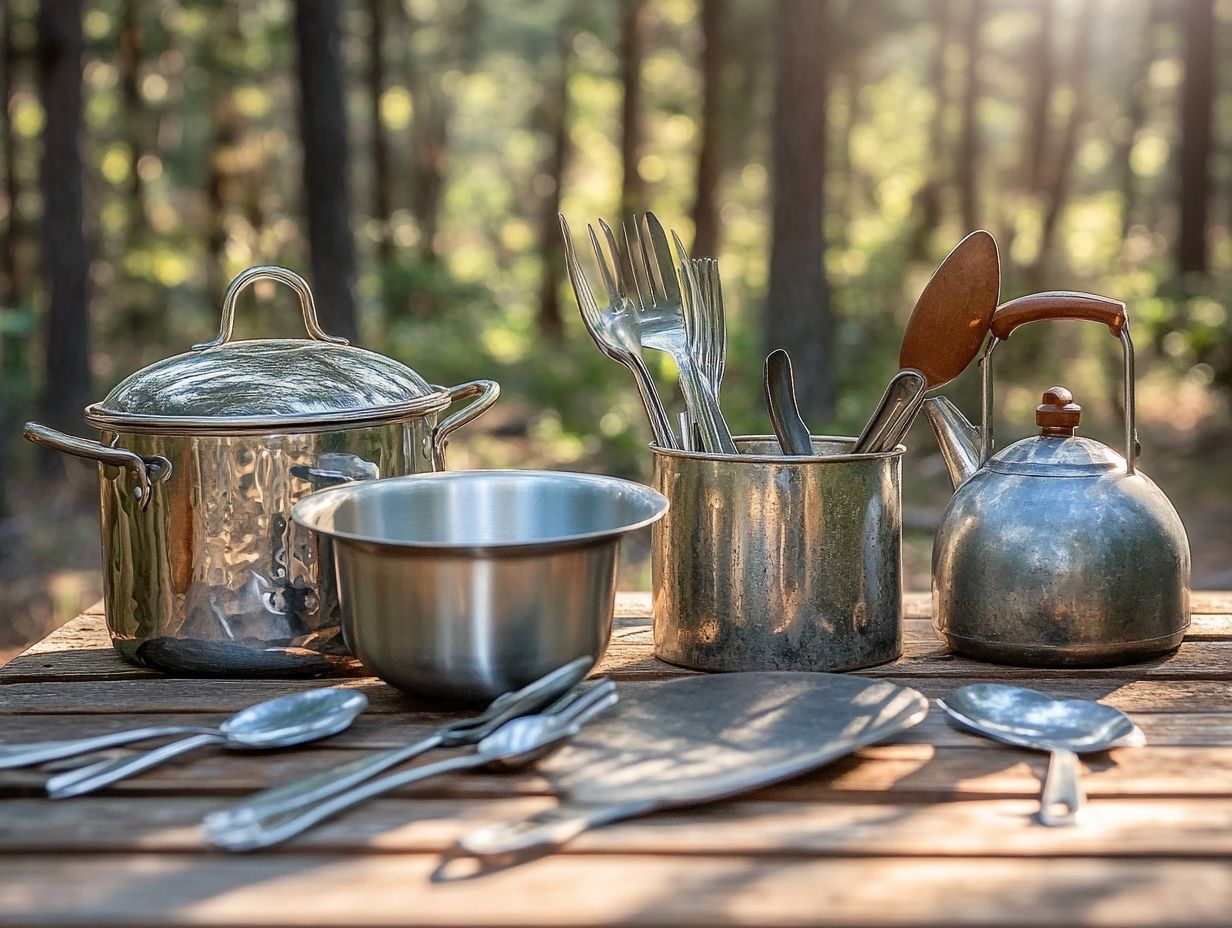
Selecting the right camping cookware can make a huge difference in your outdoor cooking experience. Here are some important factors to consider when choosing cookware.
What material is best for camping cookware?
The most common materials for camping cookware are aluminum, stainless steel, and titanium. Aluminum is lightweight and affordable, while stainless steel is durable and easy to clean. Titanium is the most lightweight and durable option, but it s also the most expensive.
How many pieces of cookware do I need for camping?
This depends on the size of your camping group and your cooking needs. Generally, a set with 2-3 pots and pans, along with some utensils, is sufficient for a small group. Larger groups may need more pieces or larger cookware.
Is non-stick coating important in camping cookware?
Non-stick coating can be helpful for easy cleaning and cooking, but it may not be necessary. Non-stick coatings can wear off quickly with outdoor use and may not be as durable as traditional cookware.
What features should I look for in camping cookware?
Some important features to consider include handles that stay cool, a nesting design for compact storage, and lids with strainer holes. Also, check for compatibility with your camping stove and whether the cookware is dishwasher safe.
What is the ideal weight for camping cookware?
The ideal weight for camping cookware depends on what you like and need. Lightweight cookware is essential for backpacking or long hikes.
But if you’re car camping, feel free to choose heavier, more durable cookware!






